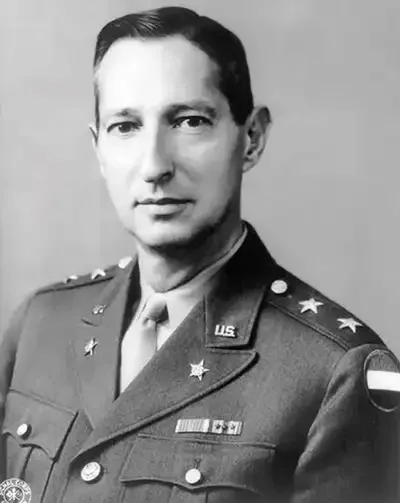- Military History
- Biographies
- Militarians Biographies
- General Mark Wayne Clark
General Mark Wayne Clark
One of the finest U.S. generals of World War II, whom Winston Churchill nicknamed the "American Eagle"
Clark was a son of the army, born at Madison Barracks in Sackets Harbor, New York, into the family of a career army officer. As a young man, he graduated from West Point and entered the infantry as a second lieutenant in 1917 and in April of the following year was sent to France with the Fifth Infantry Division. They thrust him into the thick of World War I during the Aisne-Marne offensive.
Wounded in June, he was assigned to First Army staff during the Saint-Mihiel offensive of September 12-16 and the Meuse-Argonne campaign that closed the war (September 26 - November 11). Clark remained on active duty in Germany, serving on Third Army staff during the occupation.
On his return to the States in November 1919, he was promoted to captain and served at a variety of posts in the Midwest until he was transferred to the General Staff in Washington, D.C. during 1921-24.
He graduated from the Infantry School at Fort Benning, Georgia in 1925 and in January 1933 was promoted to major. Two years later, he graduated from the Command and General Staff School at Fort Leavenworth, Kansas and in the depths of the Great Depression, was assigned to direct a contingent of the Civilian Conservation Corps (CCC) in Omaha, Nebraska (1935-36).
In 1937, Clark graduated from the Army War College and was posted to a staff position with the Third Infantry Division until 1940, when he became an instructor at the Army War College. He was instrumental in efforts to expand and prepare the army for war. Promoted to brigadier general in August 1941 and major general in April 1942, they made him chief of staff of Army Ground Forces in May. Clark was promoted to brigadier general in August 1941 and major general in April 1942, and he immediately set about organizing II Corps there when he was named commander of U.S. ground forces in Britain in July. Not gratified to serve in an office, Clark planned and took part in an extremely hazardous espionage operation to get intelligence on Vichy French forces in North Africa to prepare for Operation Torch, the Allied North African landings.
In November 1942, they promoted Clark to lieutenant general and appointed him to command Allied forces in North Africa under Dwight D. Eisenhower. Clark was among the chief architects of the invasion of Sicily and Italy launched from North Africa. Leading the Fifth Army, he landed at Salerno on September the 9th, where his forces held out against heavy defenses until Allied reinforcements and naval action checked German counterattacks during September 10-18. Clark commanded the Fifth Army in its agonizing advance up the Italian peninsula from October 1943 until June 1944.
On January 22, 1944, elements of his forces landed at Anzio and fought through ultimately to Rome on June 4. Despite the failure of the initial phase of the advance on Rome, the Anzio-Rapido Campaign (January to March 1944) Clark had acted with great enterprise deliberately defying the directives of the Fifteenth Army Group (combined U.S. Fifth and British Eighth armies) commander, British general Sir Harold Alexander. This ensured that the American army would conquer Rome, but it also allowed a strategic German withdrawal, which meant that Allied forces would continue to encounter resistance in Italy throughout the war.
Clark commanded the Allied advance across the Amo River and north to the Gothic Line during July - December and in December 1944 was named to replace Alexander as commander of the Fifteenth Army Group. As group commander, Clark directed the Allied offensive through the Gothic Line into the Po Valley and finally into Austria from the 9th of April to the 2nd of May 1945.
Following the German surrender and the deactivation of Fifteenth Army Group, Clark was named Allied high commissioner for Austria, serving in this capacity from June 1945 to May 1947, when he was made commander of Sixth Army (1947-49), then elevated to chief of Army Field Forces during 1949-52.
In May 1952, Mark Clark became the third overall U.S. commander during the Korean War, succeeding Matthew B. Ridgway, who had replaced General Douglas MacArthur after the latter was relieved by President Harry S. Truman.
Clark remained in command in Korea until after the armistice of July 27, 1953. During his later years in the army, Clark wrote two popular memoirs: "Calculated Risk (1950)" and "From the Danube to the Yalu (1954)". He retired from the army in 1954 when he accepted the post of commandant of the Citadel, South Carolina's prestigious military academy.
General Clark retired in 1965 when he stepped down as president of The Citadel. He lived in Charleston, South Carolina, in retirement where he died on April 17, 1984, shortly before his 88th birthday. He was the last surviving officer who had held four-star rank during World War II. They buried him on the campus of The Citadel.
General Mark Wayne Clark - Quick Facts
- 11th Infantry Regiment (United States)
- 15th Army Group (United States)
- 6th Army (United States)
- 7th Army (United States)
- II Corps (United States)
- United Nations Command
- United States Army North
- WWI (1914-1918)
- WWII (1939-1945)
- Korean War (1950-1953)
- {{#owner}}
- {{#url}} {{#avatarSrc}}
{{name}} {{/url}} {{^url}} {{#avatar}} {{& avatar}} {{/avatar}} {{name}} {{/url}} - {{/owner}} {{#created}}
- {{created}} {{/created}}
























